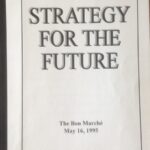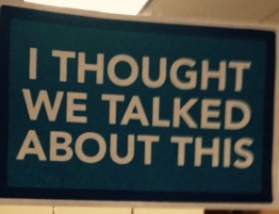
SEATTLE LEADS THE NEXT HUMAN RESOURCE REVOLUTION
April 28, 2015
How Will Your Organization Handle Disruption?
May 27, 2015WHICH WOULD YOU RATHER HAVE?
A GREAT ORGANIZATIONAL STRATEGY
OR
A GREAT ORGANIZATIONAL CULTURE?
In all the organizations I have been associated with, defining the business strategies has always been a top focus priority for the management team.
The development of:
- a Vision and Mission statement
- a 5 year Strategic Plan
- a Branding strategy
- a Marketing strategy
- a Continuous Improvement initiative
- a Reward Program [generally focused on business growth and employee competition]
- audits, business dashboards, and expense control.
These are the primary elements that senior management use to focus the organization on profit and return on investment.
The majority of the meetings and management-to-staff communications revolve around these specific topics.
The major thing that disrupts focus on these elements usually comes in the form of a crisis [something that happens that takes the focus away from these operational strategies].
Human Resource departments play the role of maintaining order, executing the effort to mitigate employee issues, and maintains the legal responsibilities required by the City, County, State and Federal employment laws.
Staying focused on all of these strategies creates the Organizational Culture.
The health of this Culture is depends on how management interacts with employees while executing all of these operational strategies.
This has been the business operational model for over the last 30 years, and as long as you are in a production business, this model has accomplishes growth and profitability goals.
I contend that this business operational model will not continue to work going forward. The new business focus is being challenged by two specific changes in the demand for products.
FIRST – the fact that we are now in a business climate where product innovation and demand for new forms of products will dominate the focus of every organization, in every product category.
SECOND – the new majority in the workforce will be Millennials [age 20-35], and the way they work and relate to their business lives will not be compatible with the business strategies of the last 30 years.
What’s Next?
In the next 10 years, up to 75% of the current technology will be replaced with a different and more intuitive technology. The Baby Boomers are done consuming and will start to downsize their lifestyles – getting rid of possessions that their children do not want to keep.
The Millennial generation is not consuming the way the Boomers consumed, and, in fact, might be more focused on a minimalist lifestyle. These factors combine with the fact that for the first time in history, there are now 3 different generations in the work force: the Boomers want to stay relevant but only working part time, the Generation Xers just want to get things done, and the Millennials, have a totally different mindset on how their personal life and their work life should be integrated. They believe that the Boomer lifestyle of “work first – play later”, needs to shift so that work and play are equal in importance.
So, what does all this mean in creating a organizational culture going forward? Can you really do a 5 year strategic plan? Do reward programs that reward competition really motivate employees to work harder? Can your workforce adapt to this rapid level of disruptive change? Does cost saving management [Continuous Improvement] create the innovation that will dominate this new business climate?
Operational strategies during the last 30 years, when our main focus was improving production of consumed products by lowering costs, is now at the end of its business cycle. The next 30 years will be about innovation, and the new consumer products will be created by organizational cultures that are smart and can maximize the impact of continuous change and adaptation – creating new ways to accomplish almost everything we do in our society.
In the past 30 years culture was driven by our organizational business strategies.
For the next 30 years culture will drive our organizational business strategies.
For the last 30 years the core objective of business was creating cheaper products.
For the next 30 years the core objective of business will be innovation of products.
For the last 30 years the Human Resource function was to manage human expenses.
For the next 30 years the Human Resource function will be to Hire, Retain, and support smart employees that innovate and collaborate to create new value.
The next 30 years will be about an organizational culture that supports
CREATING THE “ALL-IN CULTURE”
There are four elements to creating an “All-In Culture”:
All stakeholders share a relentless “ALL-IN” to accomplish the organization’s mission and desired outcomes.
All organizational stakeholders are “ALL-IN” owning and adhering to the organizational process and protocols.
All organizational stakeholders are “ALL-IN” understanding the individual leadership and management behaviors that are the foundation for Collaborative/Innovative cultures.
All organizational stakeholders are “ALL-IN” trusting organizational “Decision Competency”.
Innovation is a product of a Collaborative Organizational Culture.
Organizational flexibility only happens when no-one ever says:
“This is the way we have always done it”
Surviving the next 30 years will require an Organizational Culture that fosters change and risk, with everyone being ALL- IN to do what’s needed.






1 Comment
Spot on John. I’m in the middle of that changing workplace now, working with all 3 generations across, sales, marketing, social media, production, an operations at an MCN; Machinima. The millenials are brilliant, intuitive, working in a world they love, and only no that one vertical. The Gen Xers are organizing, setting operational structures, and the young boomers are running the business. The “all-in” culture is defined by the company culture that has been set by the CEO. What the company is for 2016 and the four core values preached constantly on monitors around the office and in company meetings. The challenge is giving the millenials the space they need to create, and let them go do it, while the rest of us integrate the business model into what they do.